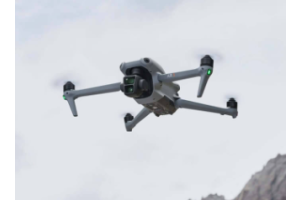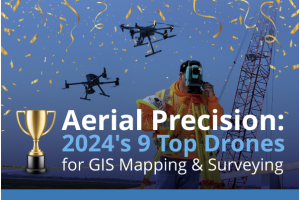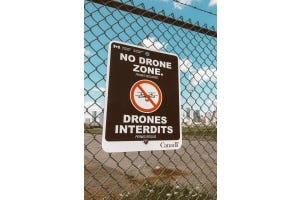
A Tale of Two Drones
DJI is already a household name when it comes to drones. Its new release, the AIr 3, has amped up the ante. How does it compare with already established drones?


The Air 3 is already creating a buzz among drone enthusiasts worldwide. It's shaping up to be a formidable competitor to its predecessor, the DJI Air 2S. Can it dethrone it?
The Air 2S won hearts with its solid performance and great camera capabilities – even ranking on the top long-range drones for 2023. But is this enough to retain its grip on the lead?


With the stage set for an intriguing face-off, it's time we examine these drones to find out what each has to offer and how they stack up against each other.
Size and Travel-Friendliness
One of the cool things about the DJI Air series is that they're super easy to carry around depsite being packed with lots of tech. The Air 3 continues this tradition, with dimensions of 207×100.5×91.1 mm (L×W×H) when folded and a weight of 720g. Although marginally larger and heavier than the DJI Air 2S, which weighs 595g and clocks in at 180×97×77 mm when folded, the Air 3 remains a highly portable choice.
Design tweaks in the DJI Air 3 have resulted in a slightly increased footprint. However, the extra weight and size are not significant enough to be a deterrent for the travelling drone polot. In fact, the additional heft might be seen as an acceptable trade-off considering the impressive new features comes loaded with.
The DJI Air 2S, with its compact size and lighter weight, still holds its own in the travel-friendliness stakes. Both drones, despite their differences, maintain a strong commitment to portability and user convenience.
Camera Capabilities
This is where it's at. The camera. The make or break actor with every drone. Both the DJI Air 3 and Air 2S have a lot going for them here. The DJI Air 3 features a dual-primary camera system, an unprecedented feature in the Air series. This system includes a wide-angle camera and a 3x medium tele camera (both 1/1.3-inch-CMOS).
Key features of DJI Air 3's camera system include:
- A consistent image quality due to dual primary cameras.
- Dynamic imaging possibilities for enhanced creativity.
- Dual native ISO and 4K/100fps HDR video output for vibrant colors and smooth lighting transitions.
Source: DJI
The DJI Air 2S, although equipped with a single camera, doesn't fall short in delivering stunning visuals. Its 1'' CMOS image sensor and large 2.4μm pixels ensure detailed images. However, without dual cameras, it lacks the dynamic imaging possibilities offered by the Air 3 – including D-Log M and HLG color modes (both 10-bit). Its camera offers 20 MP capacity and 5.4K/30fps video recording.
In conclusion, while the DJI Air 2S's camera provides impressive detail and quality, the DJI Air 3 takes the game to a new level with its dual-primary camera system, opening the door to new creative possibilities.
Aerial Action – From Flight Time to Obstacle Avoidance
Flight performance determines how much actual use you can get out of your drone.
The DJI Air 3 clearly surpasses the DJI Air 2S with an impressive maximum flight time of 46 minutes, a significant jump from the Air 2S's 31-minute cap. This longer flight duration offers more creative freedom and extended shooting possibilities.
Obstacle sensing capabilities set these two drones apart as well. The DJI Air 3 marks a first in the Air Series with its omnidirectional obstacle sensing. This comprehensive sensing allows the drone to detect obstructions in all directions, providing a safer flight experience. The DJI Air 2S, in contrast, offers sensing in only four directions.
Moreover, the Air 3 comes equipped with the next-gen O4 video transmission, enabling a maximum range of 20 km with a 1080p/60fps live feed, a significant improvement from the Air 2S's O3 video transmission with a range of 12km and 1080p/30fps live feed.
To summarize,
• DJI Air 3 boasts a maximum flight time of 46 minutes, omnidirectional obstacle sensing, and O4 video transmission for extended range.
• DJI Air 2S offers a maximum flight time of 31 minutes, 4-direction obstacle sensing, and O3 video transmission.
Intelligent Features
Both the DJI Air 3 and DJI Air 2S are equipped with several intelligent features that set them apart from the crowd. However, there are key differences in the innovations each drone brings to the table.
The DJI Air 3 introduces the Waypoint feature, which allows users to plan flight routes and shooting actions in advance, providing a richer, more organized shooting experience. It also brings an upgrade to the ActiveTrack system, now version 5.0. This feature employs multiple vision sensors to lock subjects within the frame, allowing for seamless adjustments of tracking angles and more natural-looking results.
The DJI Air 2S, on the other hand, features ActiveTrack 4.0, but it does not include the new Waypoint feature, making it less flexible in terms of pre-planned flight paths.
Further, the DJI Air 3 is compatible with the updated DJI RC 2, a remote controller with dramatically improved performance and an upgraded video transmission solution. This controller allows for angle adjustments to optimize video transmission effects.
To summarize,
• DJI Air 3 features the new Waypoint feature, ActiveTrack 5.0, and is compatible with the DJI RC 2.
• DJI Air 2S is equipped with ActiveTrack 4.0 but lacks the Waypoint feature.
ActiveTrack 5.0 in action
Remote Control
The thrill of piloting a drone comes to life through the remote controller. DJI recognizes this and has continually improved their controllers to meet the evolving needs of users. The DJI Air 3 is paired with the DJI RC 2, a revamped controller that brings a host of improvements. Here's what it offers:
• The DJI RC 2 boasts significantly enhanced performance for a smoother operational experience.
• Upgraded video transmission capabilities ensure that the real-time feed from your drone is crystal clear.
• A shift from the 1T2R antenna system to 2T4R in DJI RC 2 makes for more reliable and efficient communication.
In comparison, the DJI Air 2S's controller, while highly functional, lacks these upgrades. The improvements on the DJI RC 2, designed for DJI Air 3, makes controlling your drone not just easier but also a more immersive experience.
Wrapping Up
With innovative camera capabilities, improved flight performance, and an enhanced remote controller, the DJI Air 3 appears to edge out the DJI Air 2S. It's an exciting time for drone enthusiasts, and the choice between the two depends on your specific needs and what you value most.
Watch it's unveiling video here:







